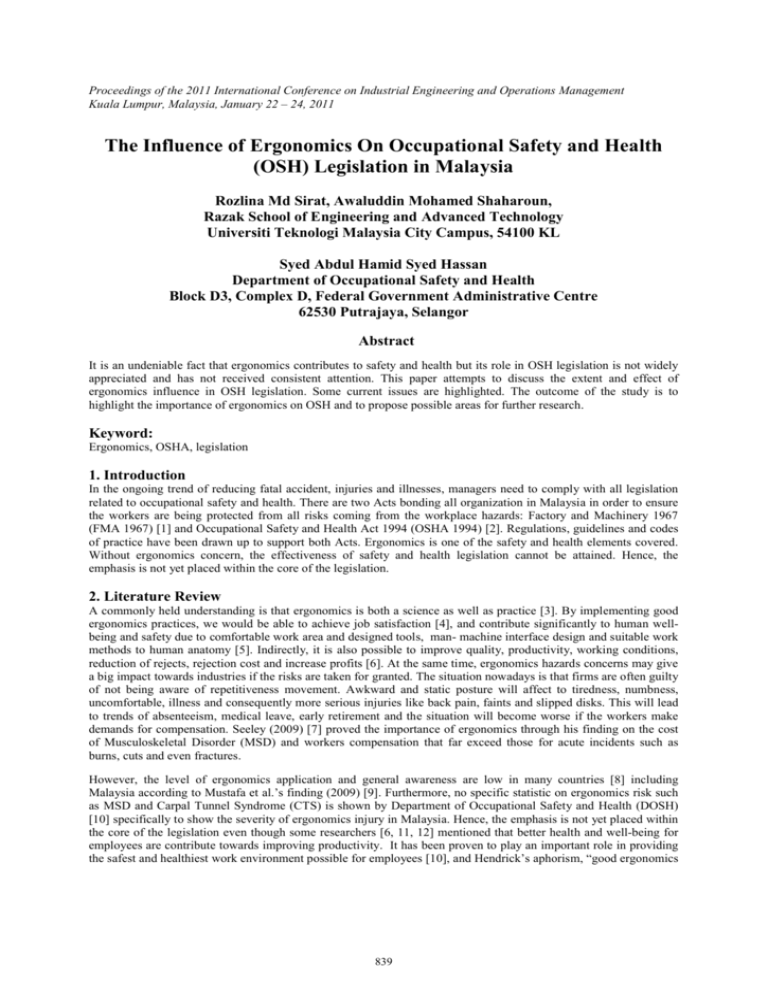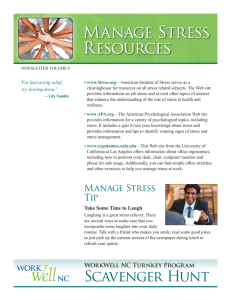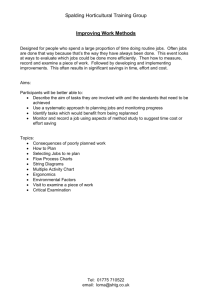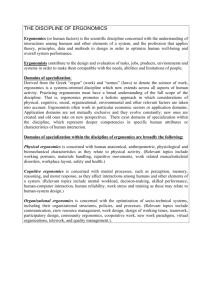
Proceedings of the 2011 International Conference on Industrial Engineering and Operations Management
Kuala Lumpur, Malaysia, January 22 – 24, 2011
The Influence of Ergonomics On Occupational Safety and Health
(OSH) Legislation in Malaysia
Rozlina Md Sirat, Awaluddin Mohamed Shaharoun,
Razak School of Engineering and Advanced Technology
Universiti Teknologi Malaysia City Campus, 54100 KL
Syed Abdul Hamid Syed Hassan
Department of Occupational Safety and Health
Block D3, Complex D, Federal Government Administrative Centre
62530 Putrajaya, Selangor
Abstract
It is an undeniable fact that ergonomics contributes to safety and health but its role in OSH legislation is not widely
appreciated and has not received consistent attention. This paper attempts to discuss the extent and effect of
ergonomics influence in OSH legislation. Some current issues are highlighted. The outcome of the study is to
highlight the importance of ergonomics on OSH and to propose possible areas for further research.
Keyword:
Ergonomics, OSHA, legislation
1. Introduction
In the ongoing trend of reducing fatal accident, injuries and illnesses, managers need to comply with all legislation
related to occupational safety and health. There are two Acts bonding all organization in Malaysia in order to ensure
the workers are being protected from all risks coming from the workplace hazards: Factory and Machinery 1967
(FMA 1967) [1] and Occupational Safety and Health Act 1994 (OSHA 1994) [2]. Regulations, guidelines and codes
of practice have been drawn up to support both Acts. Ergonomics is one of the safety and health elements covered.
Without ergonomics concern, the effectiveness of safety and health legislation cannot be attained. Hence, the
emphasis is not yet placed within the core of the legislation.
2. Literature Review
A commonly held understanding is that ergonomics is both a science as well as practice [3]. By implementing good
ergonomics practices, we would be able to achieve job satisfaction [4], and contribute significantly to human wellbeing and safety due to comfortable work area and designed tools, man- machine interface design and suitable work
methods to human anatomy [5]. Indirectly, it is also possible to improve quality, productivity, working conditions,
reduction of rejects, rejection cost and increase profits [6]. At the same time, ergonomics hazards concerns may give
a big impact towards industries if the risks are taken for granted. The situation nowadays is that firms are often guilty
of not being aware of repetitiveness movement. Awkward and static posture will affect to tiredness, numbness,
uncomfortable, illness and consequently more serious injuries like back pain, faints and slipped disks. This will lead
to trends of absenteeism, medical leave, early retirement and the situation will become worse if the workers make
demands for compensation. Seeley (2009) [7] proved the importance of ergonomics through his finding on the cost
of Musculoskeletal Disorder (MSD) and workers compensation that far exceed those for acute incidents such as
burns, cuts and even fractures.
However, the level of ergonomics application and general awareness are low in many countries [8] including
Malaysia according to Mustafa et al.’s finding (2009) [9]. Furthermore, no specific statistic on ergonomics risk such
as MSD and Carpal Tunnel Syndrome (CTS) is shown by Department of Occupational Safety and Health (DOSH)
[10] specifically to show the severity of ergonomics injury in Malaysia. Hence, the emphasis is not yet placed within
the core of the legislation even though some researchers [6, 11, 12] mentioned that better health and well-being for
employees are contribute towards improving productivity. It has been proven to play an important role in providing
the safest and healthiest work environment possible for employees [10], and Hendrick’s aphorism, “good ergonomics
839
Proceedings of the 2011 International Conference on Industrial Engineering and Operations Management
Kuala Lumpur, Malaysia, January 22 – 24, 2011
is good economics” [11], ergonomics is still not a hot issue to be considered by many companies. According to Niu
(2010) [13], existing national and international ergonomics standards and guidance have some deficiencies including
narrow focus on some physical hazards, inadequate coverage of issues related to effective program implementation
and inadequate attention given by document designers to document usability. This paper aims to study the extent of
ergonomics issue in OSH legislation and the outcome is going to highlight possible areas for further research.
3. Ergonomics concern in Act, regulation and guidelines in Malaysia
OSH Act must be approved by Parliament while the OSH regulation must be endorsed by the Human Resource
Ministry. Guidelines should be endorsed by the General Director of DOSH. Acts and regulations are seen as a
method of solutions for the time being for the implementation of ergonomics in Malaysia. It is capable of being a
push factor to companies which comply with it. There are two types of issue brought up in this legislation: technical
issues and management issues. Normally OSHA focuses on management issues while FMA 1967 tackled on
technical issues. Table 2, Table 3 and Table 4 show the ergonomics involved in acts, regulations or guidelines based
on management or technical issues.
3.1
Act and regulation relevant to Ergonomics in OSHA
Ergonomics under OSHA is referred to direct and indirect statements (refer Table 2 no 1-6) and the contents are in
the main, more directed towards management issues. For example, in objective (sec. 4(c) OSHA 1994) such as, “to
promote an occupational environment for persons at work which is adapted to their physiological and psychological
needs”. Even though the statement does not mention ergonomics directly, “physiological and psychological” refers to
ergonomics. Safety policy is required as mentioned in OSH (employers’ Safety and Health General Policy
Statements) (Exception) Regulation 1995. Nevertheless, it depends on employers to develop the policy and put the
emphasis on safety, health or ergonomics. Here the significant role of employers is to put an effort of ergonomics as
a priority, where by the content of policy should strongly emphasize ergonomics in practice. In Sec. 28 (Medical
Surveillance), sec. 31 (Function of Safety and Health Committee), sec. 32 (Notification Of Accidents, Dangerous
Occurrence, Occupational Disease And Inquiry) and sec. 66 (Minister Power To Regulate Or Prohibit), the detail
explanations should be done to ensure the company understand the essence concerning ergonomics. This is important
because the employers are bound by the statements (refer Table 2 no 2 to 4). The comments are set out at the right
for each issue.
Table 2: Ergonomics mentioned in Act and regulation
Issue
Detail in the
Act or regulations relevant to
Comments
category (FMA/
ergonomics (summary)
OSHA)
Direct and strong relation between
1 Objective of Sec. 4 OSH Act The objective of OSH :
ergonomics and the OSH objectives.
- To promote an occupational
OSHA
1994
environment for persons at work which is
adapted to their physiological and
psychological needs.
2 Safety and
health
(S&H)
policy
Sec. 16 OSH
Act 1994
………to prepare …. a written statement
of general policy with respect to the
safety and health at work.
Indirect but strong relation between
ergonomics and S&H policy. It is more
towards awareness of employer to set a
safety policy with ergonomics emphasis.
3 Medical
Surveillance
Sec. 28 OSH
Act 1994
-...by reason of changes in any process …
there may be risk of injury to the health
of persons employed in the process.
4 Functions of
SHO
Sec. 15 OSH
Act
..duty extends include in particular :
a) Provision and maintenance of plant ..
b) Making arrangement..
Indirect and strong relation. Ergonomics
falls within one of the safety and health
scope. Need to establish a base against
which changes in health care status can be
evaluated [14].
the ergonomics has too much uncertainty
[15]. Thus, SHO difficult to collect, analyse
data and to measure the risk without any
strong knowledge and expertise.
Reg. (18) Safety
and Health
Officer under
OSHA 1994
.... to investigate new miss .. to collect,
analyse and maintain statistics on any
accident
840
Proceedings of the 2011 International Conference on Industrial Engineering and Operations Management
Kuala Lumpur, Malaysia, January 22 – 24, 2011
5 Functions of
safety and
health
committee
(SHC)
Sec. 31 OSH
Act 1994
Reg (11d) Safety
and Health
Committee
Regulation 1996
under OSHA 1994
6 Responsibility
of notification
Reg. (7)
NADOPOD
2004 under
OSHA 1994
The SHC shall keep under review the
measures taken …….which a member of
the committee or a person employed
thereat considers is not safe or is a risk to
health
… review safety and health policies at the
workplace and make recommendations to
the employer for any revision of such
policies.
... inspect workplace every 3 months ..
--investigate accident.. review OSH
report
An employer shall send a report in an
approved form to DOSH within 7 days
where a person at work suffers from one
of the occupational poisonings or
occupational diseases in the 3rd schedule.
Indirect but strong relation between
ergonomics and function of SHC.
Ergonomics falls within one of the safety
and health scope. However, in order to
conduct the SHC on ergonomics aspect is
still not clear except for those who involved
in accident, or for large companies, which
have their own consultant to conduct the
committee.
Indirect but strong relation between
ergonomics and responsibility in making
notification. 3rd schedule mentioned in the
NADOPOD: (under OSHA 1994),
-heat cramp/ heat stroke, inflammation of
synovial lining of the wrist joint and tendon
sheath, cramp of the hand or forearm due to
repetitive movements, hearing impairment
caused by noise, diseases caused by
vibration. Difficult to identify at the early
stage.
Under the regulation category, employers are bond with NADOPOD (Reg. 7 under OSH 2004) which explained the
requirements of reports of occupational poisoning and occupational disease. A well-conceived explanation is
required as there are hidden statements whereby companies should refer under 3rd schedule with ergonomics problem
such as heat cramp/ heat stroke, hearing impairment and noise (which is listed in eight (8) pages of occupational
poisoning and occupational disease category). However, the implication is difficult, as the detail is not provided to
explain the limits that can be abided to control heat cramp, heat stroke etc. Reactive approach is used typically by
receiving complaints from workers or when ergonomics injuries such as Musculoskeletal Disorder (MSD) and
Carpal Tunnel Syndrome (CTS) happened. Normally, this will take a long period for the problem to be detected until
the symptoms emerge. Thus, it needs a proactive approach to do risk assessment.
3.2
Act and regulation relevant to Ergonomics in FMA 1967
Factory and Machinery Act (FMA) approach is slightly different compared to OSHA. FMA tackled the technical
issue as this provides the employer on how to identify, analyse and improve the ergonomics hazard. Limits are given
as a requirement. When product or services exceed the national limits, some penalty will be liable. There is only one
specific regulation dealing on ergonomics i.e. noise (Noise regulation 1989 under FMA 1967). The regulation
describes in technical detail even though management or implementation steps are not emphasized (refer Table 3 no.
1). The other regulation consider ergonomics is stated under Factory and Machinery (safety and health Welfare)
1970 regulation no. 28, 29, 30 and 31 (refer Table 3 no. 2, 3, 5 and 6), consists of temperature (heat stress), lighting
(illumination), seating facilities and workbench issue.
However, lighting (illumination) has further mentioned in construction works Regulation 20 Factory and Machinery
(Building, Operations and Work of Engineering Construction) (safety), 1986 (Table 3 no. 4). Refer to comment (at
the right of Table 3).
Table 3: Regulation relevant to ergonomics
N
o
Ergonomics
issue
1 Noise
Regulation (section)
Regulation statement relevant toergonomics
Comment
Reg. (4 ) Noise
Exposure
Regulations, 1989
under FMA, 1967
Obligation of occupier and employee….. wearing a
noise dosimeter during employee exposure
monitoring.
-wear and make full and proper use of the hearing
protection device provided for his use.
-attached for and undergo audiometric testing or any
medical examination or test arranged by the occupier
-attend employee information and training
programmes conducted by the occupier.
Direct and strong relation
between ergonomics and noise
exposure.
841
Permissible exposure limit is
described in detail but no detail
guidelines for management of
hazards.
Proceedings of the 2011 International Conference on Industrial Engineering and Operations Management
Kuala Lumpur, Malaysia, January 22 – 24, 2011
Reg. (5) and Reg.
(6) Noise
Exposure
Regulations, 1989
under FMA 1967
2 Space
(related to
anthropome
try)
3 Height at
work room
( related to
anthropome
try)
Reg. (24) Safety ,
Health and
Welfare
Regulations 1970
under FMA 1967
Reg. (24) Safety,
Health and
Welfare
Regulations 1970
under FMA 1967
4 Temperatu
re (related
to Heat
stress)
Reg. (28) Safety,
Health and
Welfare)
Regulations 1970
under FMA 1967
5 Lighting
(related to
illuminatio
n)
Reg. (29 Safety,
Health and
Welfare
Regulations 1970
under FMA 1967
6
Reg. (20) Building
Operations and
works of
engineering
Construction
(Safety)
Regulations 1986
under FMA 1967
7 Seating
facilities
(related to
work
method
problem)
Reg. (30)Safety,
Health and
Welfare
Regulations 1970
under FMA 1967
8 Work
bench
(related to
Reg. (31)Safety,
Health and
Welfare
No employee shall be exposed to noise level of:
i) 90dB (A) or exceeding limits specified in the First
Schedule or exceeding the daily noise dose of
unity.
ii) exceeding 115dB (A) at any time.
iii) impulsive noise exceeding a peak sound pressure
level of 140dB.
1) …. not less than four hundred cubic feet of space
for each person employed therein, and in
determining such space, all space more than
fourteen feet above the level of the floor shall not
be taken into account.
Direct and strong relation
between ergonomics and work
space
2) Every workroom shall not be less than 10 feet in
height measured from the floor to the lowest
point of any cross beam: thereof:
… or the purpose of housing machinery and in
which no person is employed full time in
attendance at such , machinery and …shall not be
less than six feet and six inches.
Suitable provision should be made to reduce the
effect of temperature as he may considerable and
practicable- adequate means shall be provided, shall
be lined with suitable insulating material or coated
with white paint, white wash or other heat reflecting
material or so lined and so coated.
Direct and strong relation
between ergonomics and height at
work place
-No person shall be permitted to …..less than 10% of
the floor area thereof.
Windows and skylight are located and spaced so that
daylights conditions are fairly uniform over the
working area.
-Intensity of illumination shall not be less than two
foot- candles or five-foot candles depend on the point
taken.
-Local lighting source shall be mounted and arranged
so as to confine the light to the immediate working
area….Prevent formation of shadows.
Illumination sufficient for maintaining safe working
conditions shall be provided wherever persons are
required to work or pass. For passageways, stairways
and landings, the illumination shall be not less than
50 lux.
Permissible Exposure limit is
mentioned but the action steps
suggested is not clear, as
employers need a guideline /
framework to ease the
management of the hazard.
… seating facilities shall be provided and maintained
suitable and sufficient seating facilities for their use.
-where a substantial portion of any work can properly
be done sitting, there should be provided and
maintained for any person employed in that work a
seat of a design, construction and dimensions suitable
for him and the work, together with a foot-rest if such
a foot rest is necessary to support his feet in order to
reduce fatigue.
-and the arrangement shall be such that the seat is
adequately and properly supported …
Every workbench or worktable shall be of a design
construction and dimensions suitable for persons
employed so that the work can be carried out without
Direct and strong relation
between ergonomics and seating
facilities. Even though the
explanation is not detail enough,
there is a guideline provided for
seating at work (See Seating at
Work Guideline, 2003)
842
General requirements is written
and employers need to have
guideline on how to manage
ergonomics practically
Direct and strong relation
between ergonomics and
illumination.
General explanation. However,
can refer to and Standing at Work
Guideline 2002 and Seating at
Proceedings of the 2011 International Conference on Industrial Engineering and Operations Management
Kuala Lumpur, Malaysia, January 22 – 24, 2011
work
method
problem)
Regulations 1970
under FMA 1967
undue strain.
Work Guideline, 2003.
Nevertheless, the measurement of
workbench height is not
mentioned for standing at work.
2.2
Guideline relevant to ergonomics
The role of ergonomics is also emphasized in some guidelines provided by DOSH. However, it is explained based on
the job. Malaysia has nine (9) guidelines relevant to ergonomics issue as shown in Table 4. However, the study
shows the role of ergonomics is only embedded in the guideline whereby the guideline is developed based on the
activities. For example, some guidelines available are Seating at Work, OSH in the Office, OSH in the Agriculture
and Logging Operations. Those are the activities that involved a lot of ergonomics principle such as workspace,
manual handling, posture and movement. As the guideline is written, the consideration is subject to the activities and
it is case-by-case issue. All activities with respect to human usage will involve ergonomics because ergonomics
means job fit to the man. Without explanation of ergonomics, the guidelines lack of values. Nevertheless, guideline
for Registration of Assessors, Hygiene Technician, Occupational Health Doctor 2000; Safety and Health in Logging
Operations 2004; Occupational and Health in Fishing and Aquaculture Operations 2003 and Occupational Health
Services 2004 do not reflex and focus to ergonomics issue. The authors feel that there needs to be further
investigation as to why ergonomics is not a widely appreciated discipline.
Table 4: Matrix on ergonomics issue in the guidelines available for OSH in Malaysia.
N
o.
Guideline
1
2
Temperature /
heat stress
Humidity
3
Ventilation
4
Vibration
5
6
Lighting/
illumination
Color
7
Noise
8
Space
9
Manual
handling
Stress
10
11
12
13
14
Ergonomics
issue
Work bench
height
Chair
Screen
placement
Posture and
movement
Key :
Guideline
on seating
at work
2003
Guideline
on
standing at
work 2002
Guideline
on
Occupatio
nal safety
and health
in the
office1996
Guideline
on
working
with VDU
2003
●
●
◘
◘
●
◘
●
◘
◘
○
◘
○
○
○
◘
◘
○
○
◘
◘
◘
◘
●
●
○
◘
●
●
●- described in detail
Guideline on
registration of
assessor, hygiene
technician and
occupational
health doctor,
2000.
-
Guidelin
es on
OSH in
agricult
ure,
2006
Guideline on
safety and
health in
logging
operation,
2004
Guideline on
safety and
health in
fishing and
aquaculture
operations,
2003
Guideline
on
Occupatio
nal Health
services,
2004
●
○
○
○
○
●
○
●
○
○
○
○
○
○
◘
○
●
○
○
○
○
○
○
○
○
○
○
-
○
-
◘- described roughly but have limit explanation
○- only mentioned, not described
Code of Practice (COP) is one of documents that can help DOSH in conveying their instruction on safety and health.
However, there is no clear or written ergonomics COP provided to assist companies in facing ergonomics risk or
hazard.
843
Proceedings of the 2011 International Conference on Industrial Engineering and Operations Management
Kuala Lumpur, Malaysia, January 22 – 24, 2011
Overall, the concept of ergonomics is explained inconsistency in Act, regulation, guideline and code of practice.
Some parts are clear but some are not detailed and are thus questionable. For example, temperature is described
briefly in regulation (just ignore the Act as it is more to management) and no detail explanation neither in regulation
nor most of the guideline excepting agriculture. Even though in the agriculture only mentioned that the comfortable
temperature is between 20-26 degree Celsius, yet it is considered helpful in assisting the employers to be aware of
the environment mentioned in Section 15(2)(e), OSHA 1994 So as the posture and movement that should be given
strong emphasis, are not explained significantly.
4. Conclusions
There is considerable evidence of significant ergonomics influences in OSHA but its role has either been ill defined,
understood and perhaps confused. There is no specific act, regulation, or guideline available to explain ergonomics
implementation in general much like what Safety issues have done for the Act (OSHA emphasized on the safety
management at the workplace such as self-regulation, consultation and cooperation). Some parts of the Act refer to
ergonomics and are detailed enough to merit taking action. Others are more indirect and fuzzy. Many consideration
needs to be studied before an ergonomics Act, regulation or guideline can be developed. There is a lot of debate and
most of the question mentioned that ergonomics couldn’t be quantified especially for MSD or CTS problem.
Thus, there is a need to design a research methodology for setting a more ergonomics friendly guideline, regulation
or Act after considering some other factors such as culture and size of companies. There certainly is a lot of room for
new research in these areas to promote better industry conformity and extending its application elsewhere.
References
1. Factories and Machineries Act (1967) (Act 139) and Regulations, International Law Book Services: Kuala
Lumpur.
2. Occupational Safety and Health Act (1994) (Act 514) and Regulations, International Law Book Services:
Kuala Lumpur.
3. IEA. [retrieved in : http://www.iea.cc/ergonomics].
4. Dawal, S.Z., Taha, Z., Ismail, Z., 2009, "Effect of Job Organisation on Job Satisfaction Among Shop Floor
Employees in Automotive Industries in Malaysia," International Journal of Industrial Ergonomics
Engineering, 39(2009), 1-6.
5. Kroemer, K.H.E and Grandjean, E., 1997, "Fitting The Task To The Human: A textbook of Occupational
Ergonomics," 5th Edition, Taylor and Francis, London
6. Yeow, P.H.P and Sen, R.N., 2002, "Promoters of Ergonomics In Industrially Developing Countries (IDCs):
Their Work and Challenges,” in: Thatcher, A. (Editor), Proceeding of 3rd CybErg 2002: The third
International Cyberspace Conference on Ergonomics., International Ergonomics Association Press,
Johannesburg. 18-30.
7. Seeley, P., 2009, "A Full Commitment," Incident Prevention Magazine, October [retrieved in:
http://www.incident-prevention.com/component/zine/article/116.html.
8. Ahasan, R. and Imbeau, D., 2003, "Who Belongs To ergonomics?" Work Study, 52. (3), 123- 128.
9. Mustafa, S.A., Kamaruddin, S., Othman, Z. and Mokhtar, M., 2009, "The Effect of Ergonomics Application
in Work System on Mental Health of Visual Display Thermal Workers," European Journal of Scientific
Research, 31(3), 341-354.
10. DOSH, 2009, "Annual Report," Department of Occupational Safety and Health (DOSH): Putrajaya.
11. Tornstrom, L., Amprazis, J., Christmansoon, M. and Eklund, J., 2008, "A Corporate Workplace Model For
Ergonomic Assessment and Improvement," Applied Ergonomics, 39(2008), 219-228.
12. Tompa, E., Dolinschi, R. and Laing, A., 2009, “Economic Evaluation of A Participatory Ergonomics
Process in An Auto Parts Manufacturer," Journal of Safety Research, 40(2009), 41-47.
13. Niu, S., 2010, "Ergonomics and Occupational Safety and Health: An ILO Perspective," Applied
Ergonomics, 41(2010), 744-753.
14. Goetsch, D.L., 2005, "Occupational Safety and Health for Technologists, Engineers, and Managers. Fifth
ed., Pearson Prentice Hall. New Jersey
15. Budnick, P. Anti Regulation Group Prepares for New Fight Against Ergonomics. Ergonomics Today 2008
[retrieved in http://www.ergoweb.com/news/.
844







